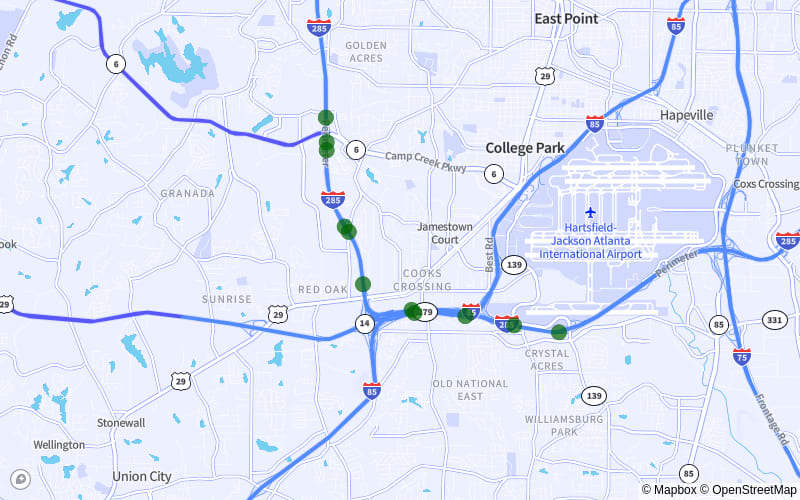Georgia Fatal Accident Study:
Georgia’s Deadliest Roads and Fatal Accident Statistics
MoneyGeek analyzed 4,307 fatal accidents that occurred in Georgia from 2018 to 2020 to determine the deadliest roads in the state. The study also identified various factors contributing to fatal motor vehicle accidents, including drunk driving, speeding, distracted driving and time of year.
 DC
DCDoug Milnes, CFA
Head of Credit Cards at MoneyGeek
Doug Milnes is a CFA charter holder with over 10 years of experience in corporate finance and the Head of Credit Cards at MoneyGeek. Formerly, he performed valuations for Duff and Phelps and financial planning and analysis for various companies. His analysis has been cited by U.S. News and World Report, The Hill, the Los Angeles Times, The New York Times and many other outlets. Milnes holds a master’s degree in data science from Northwestern University. He geeks out on helping people feel on top of their credit card use, from managing debt to optimizing rewards.
 DC
DCDoug Milnes, CFA
Head of Credit Cards at MoneyGeek
Doug Milnes is a CFA charter holder with over 10 years of experience in corporate finance and the Head of Credit Cards at MoneyGeek. Formerly, he performed valuations for Duff and Phelps and financial planning and analysis for various companies. His analysis has been cited by U.S. News and World Report, The Hill, the Los Angeles Times, The New York Times and many other outlets. Milnes holds a master’s degree in data science from Northwestern University. He geeks out on helping people feel on top of their credit card use, from managing debt to optimizing rewards.
Updated: July 21, 2022
Advertising & Editorial Disclosure

MoneyGeek looked into the 4,307 recorded fatal crashes in Georgia from 2018 to 2020 to identify which roads are the deadliest in the state. Out of Georgia's 272,662 miles of road, our analysis examined 2,404 roads.
The study explores various factors that were involved in these accidents. Some — like drunk driving, distracted driving and speeding — are connected to driver behaviors. Others — like weather and time of the year — are associated with the environment. You can also find a summary of information for each county in Georgia and the deadliest roads in each.
Key Findings
- SR-42 from S. River Industrial Blvd SE to Wylie St. SE is the deadliest stretch of road in Georgia. Between 2018–2020, 12 fatal accidents occurred here.
- Drunk driving and speeding were the most significant contributors to fatal accidents in Georgia. 20% of all deadly crashes involved distracted driving, while speeding was connected to 18.7%
- Georgia has one of the lowest incidents of distracted driving of any state. Distracted driving was involved in just 3.6% of the state's fatal crashes from 2018 to 2020. Georgia ranks better than 88% of states for distracted driving fatalities, according to MoneyGeek’s distracted driving study.
- October had the highest number of deadly crashes of any month from 2018 to 2020, with 396 fatal accidents; that’s 9.2% of all recorded deadly crashes in Georgia in a three-year period. September and November had the next highest numbers, with 394 and 384, respectively.
- Fulton had the most fatal accidents of any county. The majority of these accidents happened on I-285.
10 Deadliest Road Stretches in Georgia
- DEADLIEST ROAD IN GEORGIAMoreland Ave. (Georgia 42) from S. River Industrial Blvd. SE to Wylie St. SEDecatur | Atlanta

- Fatal Accidents:12
- fatalities:13
- Crashes Per Mile:2.5
- distance:4.8
- I-20 from Exit 71 to Exit 65Decatur

- Fatal Accidents:11
- fatalities:11
- Crashes Per Mile:2.2
- distance:5.0
- The Perimeter (I-285) from the Rt. 6 Interchange to the Riverdale Rd. ExitEast Point | Other | College Park

- Fatal Accidents:11
- fatalities:11
- Crashes Per Mile:2.5
- distance:4.4
- The Perimeter (I-285) from the Bouldercrest Rd Exit to the I-20 interchangeDecatur

- Fatal Accidents:10
- fatalities:10
- Crashes Per Mile:2.2
- distance:4.5
- Georgia 85 from Exit 237A to Springdale Dr.Forest Park | Riverdale

- Fatal Accidents:10
- fatalities:10
- Crashes Per Mile:2.5
- distance:4.0
- Old National Hwy. (Georgia 279) between Bethsaida Rd. and the I-85 overpassAtlanta

- Fatal Accidents:10
- fatalities:10
- Crashes Per Mile:2.6
- distance:3.8
- I-85 from Exit 71 to Exit 77East Point | College Park | Atlanta

- Fatal Accidents:9
- fatalities:9
- Crashes Per Mile:2.1
- distance:4.3
- I-285 from Exit 53 to South Loop Rd.Forest Park | Atlanta

- Fatal Accidents:8
- fatalities:10
- Crashes Per Mile:2.1
- distance:3.7
- Georgia 6 from Riverside Pkwy. to Maxham Rd.Douglas County

- Fatal Accidents:8
- fatalities:9
- Crashes Per Mile:2.0
- distance:3.9
- I-285 from Exit 25 to US Hwy. 41Marietta | Sandy Springs

- Fatal Accidents:7
- fatalities:8
- Crashes Per Mile:1.5
- distance:4.8
Drunk Driving Involved in 20% of Fatal Accidents
Between 2018 and 2020, there were more fatal crashes involving drunk driving than other factors, including speeding, distracted driving and winter weather. That’s 20% of all recorded accidents in the state resulting in fatalities, translating to 860 incidents.
A blood alcohol concentration (BAC) of 0.08% makes you legally drunk in Georgia. However, a lower BAC is enough to impair your driving. Just two alcoholic drinks bring your BAC up to 0.02%, leading to an altered mood and a more relaxed state. Multitasking and visually tracking moving targets become challenging. Unfortunately, both of these skills are essential to your safety when you’re behind the wheel.
Fatalities from a drunk driving incident are a worst-case scenario. But even if it doesn’t come to that, the consequences of driving drunk can be extensive. These include lost driving privileges, fines and possible jail time. Drivers with DUIs also have more difficulty finding affordable car insurance in Georgia. These drivers are required to carry Georgia SR-22 insurance, which is more expensive than any other coverage.
Speeding Is a Factor in 19% of Fatal Crashes
Speeding was involved in 18.7% of all fatal accidents recorded in Georgia from 2018 to 2020. That translates to 805 deaths.
Unfortunately, this trend isn’t specific to Georgia. The National Safety Council pegged speeding as a contributing factor to 29% of all fatal crashes in the U.S. in 2020. Speeding reduces the time drivers have to react in hazardous situations, increases the necessary stopping time and makes safety structures and devices less effective.
Distracted Driving Contributed to 4% of Fatal Accidents
Distracted driving was a factor in 157 fatalities in Georgia. That’s 3.6% of deadly crashes between 2018 and 2020. MoneyGeek’s study on the worst states for distracted driving found that Georgia ranked better than 88% of states.
In July 2018, Georgia’s Hands-Free Act took effect to address distracted driving, which may have contributed to the low number of deaths related to distracted driving in the state.
October Had More Fatal Accidents Than Any Other Month
Besides driver behaviors, MoneyGeek’s study also analyzed the time of the year when most fatal accidents in Georgia happened. Results showed October had the highest number at 396, accounting for 9.2% of all deadly crashes. The two months with the next-highest numbers were September (394) and November (384).
Driving Safely Protects You, Others and Your Wallet
Driving responsibly allows you to do your part in keeping Georgia’s roadways safe. However, the benefits of safe driving also extend to your finances. The cost of repairs after a collision can be expensive, but having affordable full coverage auto insurance can make it more manageable. Despite your best efforts, accidents can happen.
The average cost of car insurance in Georgia is $1,638 per year; however, rates can vary depending on where you live. For example, car insurance in Atlanta, Georgia’s most populous city, costs as much as the state average. However, you only pay $1,200 for auto insurance in Augusta — a difference of $438.
Remember that the figures above are averages. Your personalized quote may show a different rate because of your unique profile, which considers your age and driving history. Comparing estimates from multiple providers can help you find the cheapest car insurance company for you.
Fatal Accidents and Most Dangerous Roads: County Breakdown
The five counties with the most deadly crashes contributed 1,150 incidents. That’s over a quarter of all fatal accidents in Georgia between 2018 to 2020.
Out of all the counties in Georgia, Fulton had the highest number of fatal accidents at 375. Most of these occurred along I-285 and involved speeding and drunk driving.
Methodology
MoneyGeek analyzed 2018, 2019 and 2020 fatality data from the National Highway Traffic Safety Administration Fatal Accident Reporting System (FARS) database. Currently, 2020 is the latest data available in the system.
About Doug Milnes, CFA

Doug Milnes is a CFA charter holder with over 10 years of experience in corporate finance and the Head of Credit Cards at MoneyGeek. Formerly, he performed valuations for Duff and Phelps and financial planning and analysis for various companies. His analysis has been cited by U.S. News and World Report, The Hill, the Los Angeles Times, The New York Times and many other outlets.
Milnes holds a master’s degree in data science from Northwestern University. He geeks out on helping people feel on top of their credit card use, from managing debt to optimizing rewards.
sources
- Centers for Disease Control and Prevention. "Impaired Driving: Get the Facts." Accessed June 16, 2022.
- Federal Highway Administration. "Highway Statistics Series." Accessed July 1, 2022.
- Georgia Governor’s Office of Highway Safety. "Hands-Free Law." Accessed June 17, 2022.
- National Highway Safety Administration. "Fatal Accident and Reporting System (FARS)." Accessed June 1, 2022.
- National Safety Council. "Speeding." Accessed June 16, 2022.











